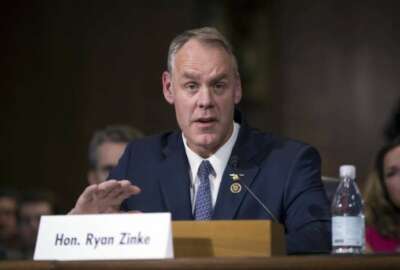
Energy Department thinking green when tackling federal real property improvements
The Department of Energy's Federal Energy Management Program recently awarded 21 contracts to energy service companies to help the government increase energy...
Federal real property is getting greener, one lighting fixture, window treatment and HVAC system at a time.
The Department of Energy’s Federal Energy Management Program [FEMP] recently awarded 21 indefinite delivery/indefinite quantity contracts to energy service companies [ESCOs] to help the government increase energy savings and lower operating costs.
“The core scope of work that these contracts cover are energy efficiency improvements, the types of things that we can do in these contracts are quite wide and varied,” said Timothy Unruh, deputy assistant secretary of renewable power within the department’s energy efficiency office. “They can include efficiency improvements that may be a boiler plant improvement, a chiller plant improvement. It can include equipment to the air-moving equipment within the building, it can have changes in lighting, the building’s electronic control system can also be updated. The building envelope: windows, doors, installations and so forth, can also be included in these contacts.”
The contracts also include renewable energy sources for combined heat and power, such as solar panel installations, or wind-farm installations.
“We’ve seen a broad range of applications for these contracts across the federal government,” Unruh said during a phone interview with Federal News Radio.
Unruh’s office has managed these contracts and companies since 1992. The ESCOs provide their own money to improve the buildings, and the savings that accrue at that building are paid back to the company. The contracts on average last about 17 years and range between $15 million and $17 million.
“Most of the federal government’s work on energy savings performance contracts is done through the Department of Energy’s IDIQ that is offered out to all federal agencies,” Unruh said. “Other methods where energy savings performance contracts are done are with the Army — they maintain a similar type of contract — and then there are also contracts done through GSA where these happen.”
Unruh said the General Services Administration is a regular partner with FEMP, and his office has done quite a bit to help improve the overall stock of federal buildings. While GSA gets the final say on what they do with their buildings, Energy offers resources to the agency to help with their decisions.
“The reality is there is a great need for improvements across the federal buildings,” Unruh said. “There’s $135 billion of needed building repairs, and about $7.7 billion in deferred building equipment maintenance, so there’s a lot to do and there’s really not the ability for Congress to appropriate all the money necessary. That’s where these public-private partnerships of an energy saving performance contract provide such a great benefit to the federal government.”
Another benefit is that the public sector gains the expertise and experience from working with an industry partner, Unruh said.
“They know what they’re doing and they know how to make these installations work, and they know how to understand the savings, and then these companies have to stay with the contracts for this 17-year average,” Unruh said. “And they have to help make sure that the savings continues to be produced by the project.”
An array of resources
That’s not to say the program isn’t without its challenges. The contracts are complex, Unruh said, or at least more complicated than buying pencils or paper. There’s specific language and statutes, and there’s a unique process on selecting a contractor.
“Remember most of the buildings are not in Washington, D.C., they’re all over the country,” Unruh said. “A contracting officer may be located in a specific facility and they may have really only one or two opportunities to do one of these types of contracts over the career of that contracting officer. So most contracting officers maybe have done only one or two of these — if they’ve done any at all.”
There are also a number of different stakeholders involved, like the person in charge of the building’s mission, agency employees, and those who operate and maintain the building.
“A lot of different players are involved in deciding what’s the best approach to renovate the building, what’s the best approach to how the finances will work and how much savings we think are real, and how much savings that we think can be used for this contract,” Unruh said. “Then what renovations do we think are the most appropriate and what’s the expected life of this building; if these are 17-year contracts, how long will the building be in use by the federal government to be able to make sure that the private contractor is repaid in full for their investment.”
Getting to a consensus can even be slowed down if there’s even one dissenting voice, Unruh said.
But Unruh said neither agencies nor contractors should be discouraged, and in fact, FEMP has a “whole array of resources” to help with the process.
“The first stage that usually an agency will experience is something called the federal project executives. These are people who work for Oak Ridge National Laboratory [a laboratory managed for Energy by the University of Tennessee and Battelle Memorial Institute] but work and help us with all agencies across the government in understanding how these [projects] work. They’ll work with the contracting officer, they’ll work with the project managers, to help them understand the general way things happen,” Unruh said. “After that we have something called a project facilitator and these are more technical people that help understand the technical proposal by the contractor and help the agency negotiate with the contractor to get the best scope of work that they can for the money that’s being paid in the whole process.”
Unruh said there’s also an array of international laboratory experts across the country to help with understanding the plans.
“They can evaluate the savings calculations to ensure we have the proper saving calculations there,” Unruh said. “They can look at the scope of work. We have a legal team that helps us look at the legalities of the contract proposed, and we also have a team of procurement specialists, that are former procurement officers who can come in alongside a contracting officer who has not done this before and help them understand the process and actually know the procedures they must go through in order to file the paperwork and do the proper reviews.”
The result, Unruh said for example, can be something like the New Carrollton Federal Building in Silver Spring, Md., which achieved a 60 percent energy reduction and a 56 percent water reduction thanks to a ground source heat pump, which transfers heat to or from the ground.
“I think that energy savings performance contracts offer all types of government, from federal all the way down to local government, a great opportunity to improve their buildings, make them better places to work, live and exist, and save the taxpayers money in the long run,” Unruh said. “So I think that the great opportunities here is these can really provide improvement of a significant part of our country’s infrastructure, building and operations.”
Copyright © 2025 Federal News Network. All rights reserved. This website is not intended for users located within the European Economic Area.





